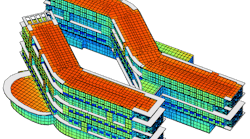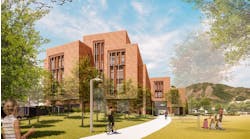A great learning environment comprises many components, not the least of which is the design of the space itself. Ideally, the right design strategies make for a learning environment whose contributions to teaching and learning are positive. In many cases these strategies are environmentally friendly and financially advantageous as well.
Ventilation, air quality, lighting choices, and the prioritization of natural daylight significantly affect performance. Design choices and room arrangements that optimize acoustics also affect the users of the space.
Beyond the technical aspects, the overarching goal is to design a sustainable, high-performance building that is also cost effective and pleasing to the occupants. Efforts by the design team to make these choices intentional promote a learning environment where students understand the impact of light, air, and acoustics working together to promote educational objectives, rather than hiding these functions in the background.
Air
Air quality is an important element for any activity but in learning outcomes, air quality can be seen as an indicator of performance. Better air quality leads to better learning outcomes and more effective crisis management.
A Harvard study in conjunction with United Technologies looked at the impact of air quality on human cognition. To test this, they varied the air quality and measured human response capacity. They found that, in crises and other situations that require complex thinking, performance improved with cleaner air.
Poor air quality is especially problematic for students, who do not have the choice to go elsewhere.
Early adopters in education design are prioritizing air quality systems that meet the demands of student housing residents, putting that knowledge into practice. Air systems and equipment designed to reduce stress by enhancing air quality lead to a reduction in the operational costs that accompany student stress, such as counselors and other behavioral support programs.
Some ventilation strategies save energy and offer better air quality. Early in the design, the key focus is finding the right CFM that delivers the targeted air quality.
When designing to meet an air quality goal of 750 to 800 ppm of CO2, the ventilation CFM introduced is usually less than typical design, which reduces the initial capital construction cost because the cost of smaller equipment more than offsets the cost of the air cleaning technology.
With more aggressive targets, such as 600 ppm, the cost begins to rise again as more sophisticated equipment is required to meet the target. Despite the higher initial cost of equipment required to reach lower targets, it reduces operating costs over time, ultimately resulting in savings. That’s because bringing in less outside air reduces the risks associated with moisture, mold, insects, smoke, fumes, or other hazards. As the technology improves, the cost of air quality monitoring equipment in general has gone down, making what once was too expensive suddenly accessible for schools.
Today, schools can meter and measure VOCs, particulate matter (PM2.5), temperature, humidity, and CO2 with a $250 wall-mounted device that communicates with a smart phone. Several devices can be placed throughout classroom and administrative space, providing instant feedback.
Light
After air quality, the most important environmental factor that impacts learning is the lighting. Historically, people have misunderstood the cognitive impact of light, especially sunlight.
Vision is about more than the retinal rods and cones that help people perceive objects, spatial relationships, and motion. A protein called melanopsin, found in the eye’s intrinsically photosensitive retinal ganglion cells (ipRGCs), absorbs light, enabling the ipRGCs to communicate with the hypothalamus to establish circadian rhythms. Light color and intensity in the environment impact the brain and thus health, alertness, and focus.
In a classroom, the activity takes place during the day, so modulating light is less of a concern than it would be at night, but the environmental and cost factors associated with harnessing natural light make it a primary consideration nonetheless.
One unexpected way to improve natural lighting is with the glazing—a critical part of the envelope that is often misunderstood. Glazing can be used like a filter to reduce UV and infrared elements that bring in heat but also allow visible light through the filter. Heat (radiation) is a larger factor than temperature difference in many cases, but the right glazing can reduce the heat.
When high performance glazing is chosen with a visible light transmittance lower than 40, it impedes the full spectrum of light from maintaining a natural circadian cycle. The solution is either to select glass with a visible light transmittance higher than 40 or be intentional about color and intensity of light in the room to recreate the same stimulus. Getting the glazing right is critical and involves architecture, mechanical, and electrical engineering expertise to get the right characteristics.
Electrochromic glass, which changes from dark to clear to mitigate glare, is one innovation in this area. Although this is relatively new technology, some energy modeling software can model electrochromic glass. When it is dark, lighting has to run at full capacity but when the glass is clear, artificial lights can be reduced to take advantage of natural daylight.
In an example project, the design team worked with manufacturers to get buy-in to the methodology, adapting energy software to accurately portray the lighting results, particularly in classrooms on the building’s east and west sides. This effort helped define priorities so they could allocate the budget effectively.
Insights
According to the Building Owners and Managers Association, the average energy bill is approximately $3/square foot, capital construction is a $30/square foot investment over 10 years, and employee and operational costs are approximately $350/square foot.
Despite this data, a hard connection between building performance and cost per square foot is difficult to make because many of the activities that do improve the building environment do not generate revenue. Any improvement, even a small percentage, is still an improvement over energy expenditures that are no longer needed when efficiency increases, so the numbers create a framework to emphasize the benefits of sustainable design.
One of the simplest ways to integrate the solutions in place is by optimizing the classroom arrangement to facilitate learning. In this area, the ROI for certain decisions is easily misunderstood, so it often becomes important to educate decision makers and integrate trades, deconstructing what they have heard and reassembling it correctly.
When discussing optimal arrangement, one classroom is a single, basic unit. The space type is often more diverse in higher education but can nonetheless be optimized for performance and energy efficiency. Examples might include cost-effective shading on the west side of a building to avoid glare or taking measures to idealize the acoustics in the room through the shape and arrangement of the room.
Integration is the tipping point for ROI. Solutions that are not integrated never deliver a payback. For example, unchecked glare destroys the careful efforts to successfully incorporate daylighting. Alternative considerations include the arrangement of windows and lights, glass quantity, lighting and controls in the room, air conditioning, and any other systems that work together to optimize comfort and functionality of the space.
Budget limitations and other project constraints mean tradeoffs will always be necessary. An example project for air quality and circadian lighting included a cost/benefit analysis on how ventilation air would be distributed and monitored throughout the building and how the feedback worked. In the example project, the goal for air quality was 600 ppm, but 750 ppm was optimal in terms of capital costs.
Equipment choices and methodology can also have a big impact on both budget and performance. Equipment either removes or dilutes air contaminants to control the air quality in the space unobtrusively while also reducing the power bill and construction cost. The removal strategy requires specific technology that can clean the room air and return it to the space. The dilution of clean air method takes ambient air, filters it intensely, and pushes the filtered air into the space, diluting extant contaminants.
Natural biophilic air filtration is another option: for example, a nature wall in a university dormitory study room connects students with nature through biophilic elements while simultaneously cleaning the air. This approach is not only aesthetically pleasing; it also, according to multiple studies, reduces stress, improves cognition, and promotes performance, among other benefits. However, the biophilic approach has associated costs.
Principles in Practice
An intentional focus on making the learning environment comfortable, healthy, and pleasant as well as environmentally sustainable can make a big impact in the final outcome of the project.
A learning environment where students can understand what these design elements are and how they work together, rather than just benefitting from hidden architecture and design, means the building itself can become a learning tool. Alignment with sustainability ratings such as LEED for schools, WELL, and others, is often a side effect of designing with intent to optimize learning in the space.
Projects that incorporate these strategies often receive all the benefits of these programs with the added flexibility to choose whichever score card that works best for verification after they have designed the facility to optimize performance and user experience.


